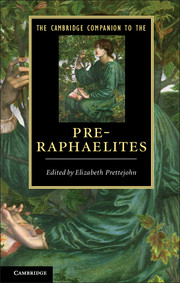Book contents
- Frontmatter
- Introduction
- PART ONE PRE-RAPHAELITISM
- PART TWO PRE-RAPHAELITES
- 6 The poetry of Dante Gabriel Rossetti (1828–1882)
- 7 The painting of Dante Gabriel Rossetti
- 8 William Holman Hunt (1827–1910)
- 9 John Everett Millais (1829–1896)
- 10 Ford Madox Brown (1821–1893)
- 11 Christina Rossetti (1830–1894)
- 12 Elizabeth Eleanor Siddall (1829–1862)
- 13 The writings of William Morris (1834–1896)
- 14 The designs of William Morris
- 15 Edward Burne-Jones (1833–1898)
- 16 Algernon Charles Swinburne (1837–1909)
- 17 William Michael Rossetti (1829–1919)
- 18 Envoi
- Appendix 1 The contents of The Germ
- Appendix 2 The Pre-Raphaelite ‘list of Immortals’
- Guide to further reading and looking
- Cambridge Companions to …
- Index
14 - The designs of William Morris
from PART TWO - PRE-RAPHAELITES
Published online by Cambridge University Press: 28 September 2012
- Frontmatter
- Introduction
- PART ONE PRE-RAPHAELITISM
- PART TWO PRE-RAPHAELITES
- 6 The poetry of Dante Gabriel Rossetti (1828–1882)
- 7 The painting of Dante Gabriel Rossetti
- 8 William Holman Hunt (1827–1910)
- 9 John Everett Millais (1829–1896)
- 10 Ford Madox Brown (1821–1893)
- 11 Christina Rossetti (1830–1894)
- 12 Elizabeth Eleanor Siddall (1829–1862)
- 13 The writings of William Morris (1834–1896)
- 14 The designs of William Morris
- 15 Edward Burne-Jones (1833–1898)
- 16 Algernon Charles Swinburne (1837–1909)
- 17 William Michael Rossetti (1829–1919)
- 18 Envoi
- Appendix 1 The contents of The Germ
- Appendix 2 The Pre-Raphaelite ‘list of Immortals’
- Guide to further reading and looking
- Cambridge Companions to …
- Index
Summary
Morris the Pre-Raphaelite
William Morris was determined to make the world a more beautiful place. The previous chapter cited one of Morris's most famous sayings: ‘Apart from the desire to produce beautiful things, the leading passion of my life has been and is hatred of modern civilization.’ In that context, the second half of this quotation was of highest importance. Here, however, the first half deserves attention. Most of Morris's life was spent responding to his ‘desire to produce beautiful things’. The ‘things’ Morris made were usually what we would categorize as ‘decorative art’, but Morris's work also challenged the divisions previously drawn between the ‘fine’ and the ‘decorative’. Working as a visual artist with his Pre-Raphaelite friends from his student days in the 1850s, Morris not only found an outlet for his urge to create beauty, but also developed another principle that would define his career: the ideal of collaboration. Through collaboration, Morris furthered his goal of combining the arts, not only the ‘fine’ and the ‘decorative’, but also the visual and the literary.
Whether we understand Pre-Raphaelitism as a historical phenomenon or as a state of mind it is a helpful concept when dealing with Morris. His work fits the bill if we define Pre-Raphaelitism as characterized by a disillusionment with contemporary artistic practice that manifests itself in the evocation of an imagined medieval period, specifically pre-Renaissance, when art was freely expressive and lacked the homogenizing polish perceived to characterize the prevailing style ever since Raphael.
- Type
- Chapter
- Information
- The Cambridge Companion to the Pre-Raphaelites , pp. 211 - 222Publisher: Cambridge University PressPrint publication year: 2012



